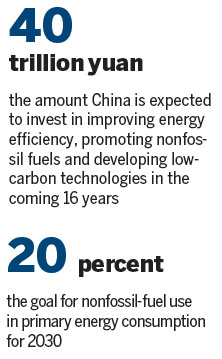China takes ambitious green path
Updated: 2015-07-01 07:36
By Lan Lan(China Daily USA)
|
|||||||||
Climate action plan for 2030 expected to open opportunities for private investment
China announced a series of objectives for cutting greenhouse gas emissions by 2030 on Tuesday as Premier Li Keqiang met with French President Francois Hollande in Paris.
The announcement sparked wide discussions about how much investment the post-2020 climate action plan would drive over the coming 16 years.
Zhang Yong, vice-chairman of China's National Development and Reform Commission, said investment in renewable energy and addressing climate change will grow "substantially".
"Such large-scale investment will need to be accelerated in both the public and private sectors," Zhang said on the sidelines of a forum in late June.
The government is working on specialized plans for the 13th Five-Year Plan (2016-20) period, and promotion of renewable energy, energy efficiency and environmental protection will be highlighted in these plans, he said.
In the coming 16 years, China's cumulative investment in improved energy efficiency, promoting nonfossil fuels and developing low-carbon technologies is expected to exceed 40 trillion yuan ($6.4 trillion), according to the National Center for Climate Change Strategy and International Cooperation, China's top climate think tank.
"These frontiers account for less than 4 percent of China's current GDP, but the contribution is expected to increase to 8 percent by 2020 and 16 percent by 2030," said Li Junfeng, director of the climate change center.
To reach the goal of increasing nonfossil fuels in primary energy consumption to about 20 percent by 2030, China needs to increase nuclear power capacity by 100 million kilowatts, hydropower capacity by 150 million kilowatts, solar capacity by 300 million kilowatts and wind power capacity by 400 million kilowatts between 2016 and 2030, according to the think tank.

China's annual power generation from nonfossil fuels will reach 4 trillion kilowatt-hours by 2030, and the use of nonfossil fuels is expected to equal 1.2 billion metric tons of standard coal in 2030.
He Jiankun, director of the Institute of Low Carbon Economy at Tsinghua University, said the renewable energy target would be equivalent to installing 10 5-megawatt wind turbines a day or 10 1-million-kilowatt nuclear power units annually between 2020 and 2030.
"Such a size and pace for renewable energy growth is unprecedented globally," he said. "China faces a tougher challenge than the developed countries to achieve the series of targets because it is in a different stage of development."
Most developed countries maintained an economic growth rate of between 2 and 3 percent when their emissions peaked. Since China is expected to maintain a growth rate of 4 to 5 percent near 2030, it will have to keep its carbon emissions per unit of GDP lower than what the developed countries did.
Adnan Amin, director general of the Abu Dhabi-based International Renewable Energy Agency, said the public sector cannot be the single primary source for realizing the energy transformation for all countries.
The government should make efforts to create a good investment environment and map out policy frameworks to help lower the costs and increase the profits of private investors, he said.
lanlan@chinadaily.com.cn
(China Daily USA 07/01/2015 page3)
- Health survey finds Chinese people have grown taller, stronger
- State Council demands accelerated housing renovation
- East China's 'most beautiful' high-speed rail opens
- Uygur family saves Han orphan
- Tourists amazed by artificial water cascades in Henan
- Greater independence needed to increase effectiveness of Chinese think tanks
- Mass casualties in Indonesian military plane crash
- Japan's LDP lawmaker denounces Abe's security policies
- More than 100 feared dead in Indonesian military plane crash
- More than 50 may die in Indonesian plane crash
- Japan's Diet gets 1.65m signatures against security bills
- Thailand's first MERS case declared free of deadly virus

 Homes on the wheels
Homes on the wheels
 Ten photos you don't wanna miss - June 30
Ten photos you don't wanna miss - June 30
 Man makes run for the money with business
Man makes run for the money with business
 1,000 students sleep in gym to avoid summer heat
1,000 students sleep in gym to avoid summer heat
 China betting big on these 10 industries
China betting big on these 10 industries
 Political ambition
Political ambition
 7 ways to make graduation travel more memorable
7 ways to make graduation travel more memorable
 Rides that turned deadly at amusement parks
Rides that turned deadly at amusement parks
Most Viewed
Editor's Picks

|

|

|

|

|

|
Today's Top News
Taking a business approach to smog
Bank framework is signed
Li sees Sino-EU economic bond as vital to growth
Obama signs trade bills into law, giving boost to TPP talks
Student arrested for killing girlfriend after China-US operation
Chinese space station for civilian use: Argentina
AIIB shows world’s economic center moving East: Opinion
European visit to find economic synergies
US Weekly

|

|







